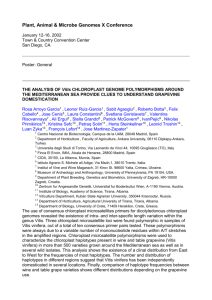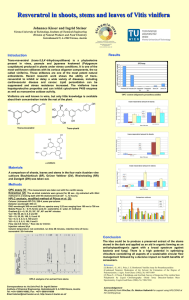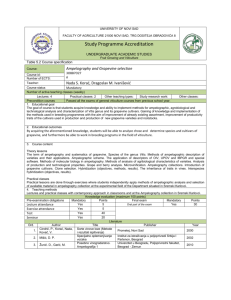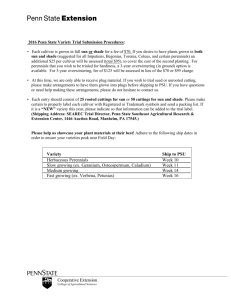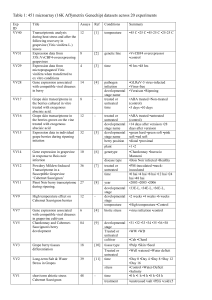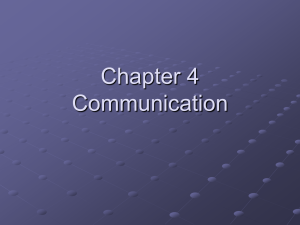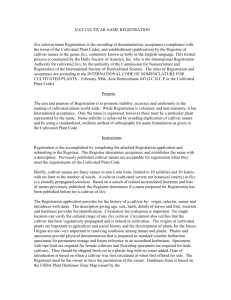Presentation slides
advertisement
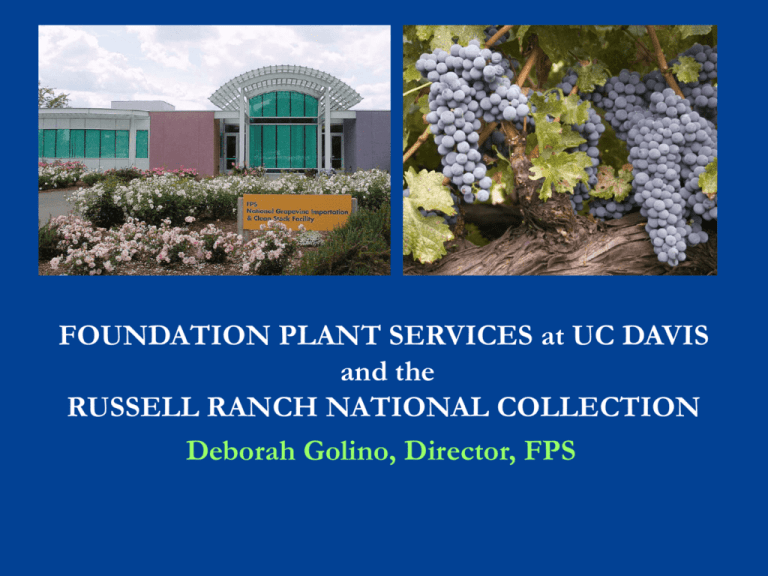
FOUNDATION PLANT SERVICES at UC DAVIS and the RUSSELL RANCH NATIONAL COLLECTION Deborah Golino, Director, FPS Foundation Plant Services: Produces, tests, maintains and distributes elite disease-tested plant propagation material Provides plant importation and quarantine services, virus testing and elimination Coordinates release of UC patented horticultural varieties Links researchers, nurseries, and producers CROP PROGRAMS AT FPS Grape Strawberry Tree Rose Sweet potato Pistachio CALIFORNIA REGISTRATION & CERTIFICATION PROGRAMS GRAPES FRUIT & NUT TREES STRAWBERRIES Why do you need clean plant material? Grapevine Virus Diseases FPS Target Grapevine Diseases Grapevine Degeneration Fanleaf Grapevine Decline Tomato Ringspot Virus Leafroll Rugose Wood Complex Kober Stem Grooving Corky Bark LN33 Stem Grooving Rupestris Stem Pitting Fleck Minor Viruses THE DANGERS OF SAMSONITE IMPORTATION PPV on nectarine Pierce’s Disease MICROSHOOT TIP CULTURE 1 mm Meristem dome Virus in protophloem Nicotiana benthamiana shoot apex infected with beet severe curly top virus . Photo courtesy Li-Fang Chen, UCDavis. Process Description: Grapevine Importation through Foundation Plant Services, UC Davis (Simplified) Document # FPS2012-01 © UC Regents S. Sim Revised March 6, 2012 YEAR 0 YEAR 1 YEAR 2 YEAR 3 YEAR 4 YEAR 5 YEAR 6 YEAR 7 YEAR 8 YEAR 9 Customer submits Service Request Form to FPS and identifies supplier. Supplier collects wood ships it to APHIS, Beltsville, MD Field Index Graft onto indicators: Cabernet franc Kober 5BB LN-33 St. George APHIS inspects forwards shipment to FPS Read leaf symptoms on St. George, Spring Read trunk symptoms on St. George, LN33, and 5BB, Summer Read leaf symptoms on Cabernet franc Fall Mist Propagated Plants Available Provisional status Yolo county inspects shipment when opened. FPS assigns Accession number and Plant ID numbers. Index buds Separate Canes into 2 Bundles 96 buds (ideal) for field index 8 canes for propagation Propagate Growing Make 8 plants 4 plants in large pots Move 4 plants to screenhouse for growing season Fungicide, Pesticide, Hot water Canes for dip propagation APHIS and Evaluate Tests Test Results negative CDFA Plant in Foundation Vineyard Mist Propagated Plants Available Provisional status Qualifies for California Registered Foundation Stock Professional Identification Grow and Train California Registered Material Available DNA and/or Visual Trunk and Cordons authorize release Tests positive LAB TEST Keep 4 plants in greenhouse for testing and tissue culture in winter Herbaceous host testing, ELISA for nepoviruses, fleck, Spring Visual Inspection LAB TEST PCR and ELISA Fall Fall LAB TEST ELISA for nepoviruses, fleck, Repeated, Spring Visual Inspection Fall LAB TEST ELISA for nepoviruses, fleck, Repeated, Spring, Field Index To determine treatment outcome Presumptive Tissue Culture Read Spring Read Summer Mist Propagated Plants Available Provisional status Read Fall Mist Propagated Plants Available Provisional status Qualifies for CA Reg. Foundation Stock Growing From 4 inch pot to 2 gallon pot; harvest woody buds for index for VIP Selections Plant Growing Growing Evaluate Tests Test neg. Results APHIS and CDFA in Foundation Vineyard Trunk/ Cordons authorize release Note: The green arrow represents a best case scenario in which a grape introduction tests negative for all viruses and establishes rapidly in the vineyard. Tests positive The purple arrows represent best case scenarios in which tissue culture treatment successfully eliminates virus and the vine establishes rapidly in the vineyard. LAB TEST To determine treatment outcome. PCR and ELISA Tests positive Visual Inspection Fall LAB TEST ELISA Repeated, Spring Field Index To determine treatment outcome Tissue Culture for virus elimination California Registered Material Available Verify ID Grow and Train Read Spring Read Summer Visual Inspection Fall Mist Propagated Plants Available Provisional status Read Fall Growing LAB TEST ELISA Repeated, Spring, Mist Propagated Plants Available Provisional status Plant From 4 inch pot to 2 gallon pot; harvest woody buds for index Growing Growing Evaluate Tests Test neg. Results APHIS and CDFA in Foundation Vineyard authorize release Tests positive Grow and Train Qualifies for CA Reg. Foundation Stock Verify ID California Registered Material Available Trunk/ Cordons LAB TEST To determine treatment outcome. PCR and ELISA Tests positive Visual Inspection Fall LAB TEST ELISA Repeated, Spring Visual Inspection Fall LAB TEST ELISA Repeated, Spring, EVOLUTION OF DIAGNOSTICS AT FOUNDATION PLANT SERVICES Biological indexing Herbaceous testing Virus infected 1. 2. 3. 4. 5. 6. Chenopodium amaranticolor C. quinoa Cucumis sativus Nicotiana benthamiana N. clevelandii N. occidentalis Healthy Biological indexing Field indexing Healthy Virus infected Woody indicator Disease St. George Cabernet franc Fanleaf, Rupestris Stem Pitting Virus, Fleck Virus Leafroll viruses LN-33 Kober 5BB Corky Bark Stem Grooving Serological techniques: ELISA • Since early 1990s Nepoviruses (GFLV, ToRSV) Leafrolls •Yr 2000 added Arabis Mosaic Virus (ArMV) •Most antibodies are produced at FPS Molecular techniques Conventional RT-PCR •1993 Fanleaf and Leafrolls • Currently FPS has developed and validated assays for 34 grapevine pathogens MagMAX-96 Molecular techniques qPCR (real-time quantitative PCR) Started using in 2001 Able to run more samples faster than ELISA and conventional PCR qPCR is more than 300 times more sensitive than conventional PCR Currently is the routine detection method at FPS PROTOCOL 2010 TESTS Next Generation Sequencing (NGS) Why use NGS technologies? •Rapid, accurate and efficient •Detects all nucleic acids (RNA and DNA) in an organism Hiseq 2000, Illumina •Known and unknown viruses Genome Sequencer FLX system, Roche NGS is like a FULL BODY SCANNER Is Red Blotch a new disease? UC Davis Center for Plant Diversity/ Herbarium • The Herbarium has over 300,000 dead plants called herbarium specimens. • Each specimen consists of a flattened and dried plant glued onto an archival paper with a label. • The label has specimen data: cultivar, place, date and the collector name. The herbarium has few un-mounted grape samples from Yolo County Example of a specimen records Sample collection • Fifty six grapevine specimens were collected (Approximately 0.5 g of leaf/petiole tissue). • specimens were originally harvested and pressed between 1937-1950. • Pieces of foil containing each sample were placed in individual Ziplock bags to prevent cross contamination. • The 56 sample bags were transported to a lab in which research on grapevine had NOT previously been conducted. Sample collection in the herbarium List of samples- Group 1: Vitis cultivars from Napa or Sonoma County Sample # Herbarium ID# 1 DAV202170 2 DAV202866 3 4 5 DAV202172 DAV202202 DAV202196 6 7 8 DAV202174 DAV202201 DAV202171 9 DAV202870 10 DAV202872 11 DAV202227 12 DAV202860 Variety/cultivar Location (County) Vitis vinifera L. cultivar Early Burgundy Sonoma Vitis vinifera L. cultivar aff. Napa Gamay Napa Vitis vinifera L. cultivar Petite Bouschet Sonoma Vitis vinifera L. cultivar Rosetta Sonoma Vitis vinifera L. cultivar Zinfandel Napa Vitis vinifera L. cultivar Black Malvoisie Sonoma Vitis vinifera L. cultivar Burger Napa Vitis vinifera L. cultivar Carignane Sonoma Vitis vinifera L. cultivar aff. Merlot Napa Vitis vinifera L. cultivar aff. Gamay Sonoma Vitis vinifera L. cultivar Grey Riesling Sonoma Vitis vinifera L. cultivar Early Burgundy Napa Year of collection Collector Tissue 1940 H. Olmo Leaves 1939-1940 H. Olmo Leaves 1937 1938? 1935 H. Olmo H. Olmo H. Olmo Leaves Leaves and petioles Leaves and petioles 1935 1935 1937 H. Olmo H. Olmo H. Olmo Leaves and petioles Leaves and petioles Leaves and petioles 1939-1940 H. Olmo Leaves and petioles; 1939-1940 H. Olmo Leaves and petioles 1938 H. Olmo Leaves and petioles 1939-1940 H. Olmo Leaves and petioles Precautions to prevent cross-contamination • Extractions were conducted in an isolated lab (The Michelmore Lab) • Samples processed with ALL new materials and reagents. GRBaV PCR Results • All herbarium samples were tested for GRBaV using both conventional and Quantitative PCR assays • Only one sample found to be positive for GRBaV (sample #1) GRBaV positive controls Herbarium sample #1 Sample #1 Cultivar: Early Burgundy Location: Sonoma Collector: H. Olmo Year of collection: 1940 What is Next: Genomic analysis Obtain the full genome sequence of GRBaV herbarium isolate and compare it with the recently sequenced GRBaV isolates. 0.1g of tissue was collected from the original specimen Total nucleic acid was extracted in an isolated lab and sent to the sequencing facility at the University of Southern California (They never worked with any grapevine material) NGS run generated about 88 million illumina reads More than 92,000 reads mapped against the GRBaV genome The herbarium isolate shared 99% identity with other genebank isolates. Summary of results The results suggest that GRBaV was present in the Sonoma wine grape growing area for at least 74 years before the virus was identified and correlated to specific symptoms. Thank you American Vineyard Foundation Fruit Tree, Nut Tree and Grapevine Improvement Advisory Board (IAB) California Grape Nurseries Thank you
